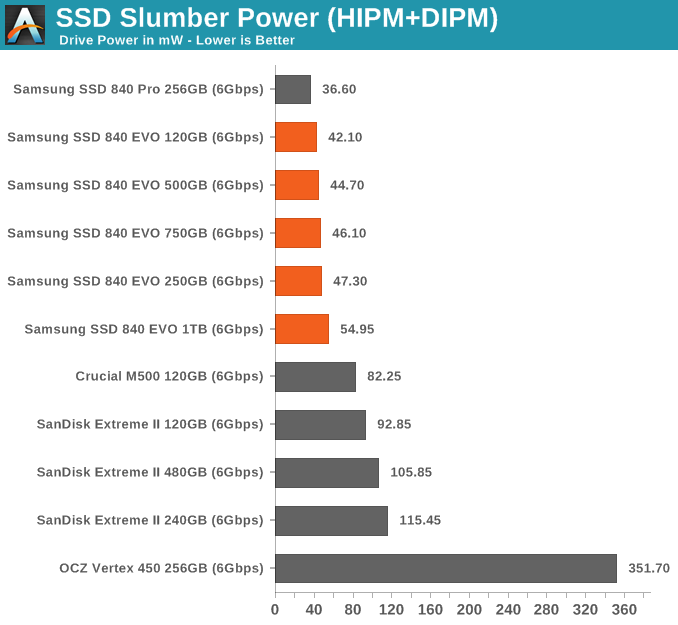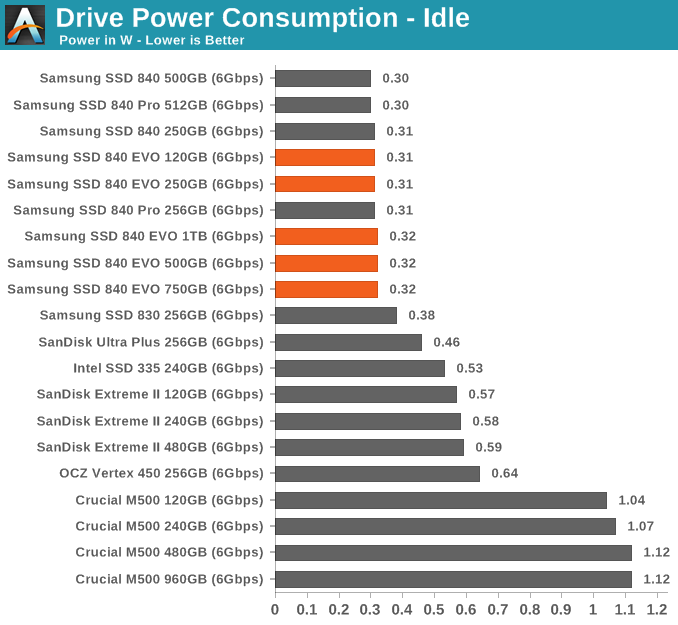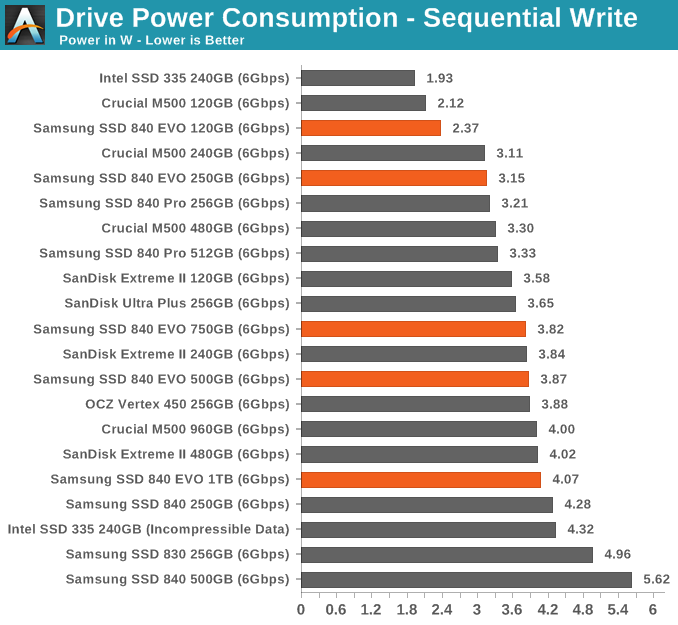Samsung SSD 840 EVO Review: 120GB, 250GB, 500GB, 750GB & 1TB Models Tested
by Anand Lal Shimpi on July 25, 2013 1:53 PM EST- Posted in
- Storage
- SSDs
- Samsung
- TLC
- Samsung SSD 840
Power Consumption
Low power consumption has always been a staple of Samsung's SSDs, and the EVO is no different. Idle and load power are among the best here. I'm also expanding our DIPM testing, first introduced in the SanDisk Extreme II review:
We're introducing a new part of our power consumption testing with this review: measurement of slumber power with host initiated power management (HIPM) and device initiated power management (DIPM) enabled. It turns out that on Intel desktop platforms, even with HIPM and DIPM enabled, SSDs will never go into their lowest power states. In order to get DIPM working, it seems that you need to be on a mobile chipset platform. I modified an ASUS Zenbook UX32VD to allow me to drive power to the drive bay from an external power supply/power measurement rig. I then made sure HIPM+DIPM were enabled, and measured average power with the drive in an idle state. The results are below:

The EVO is almost as good as the Pro from a slumber power perspective, and significantly better than anything else in the list here.













137 Comments
View All Comments
B0GiE-uk- - Thursday, July 25, 2013 - link
Seeing as this drive is similar to the 840 basic, it will be interesting to see the performance of the 840 Pro with the rapid software enabled. Has the potential to be faster than the EVO. I have heard that the rapid software will be backwards compatible.sheh - Thursday, July 25, 2013 - link
Caching speed is based on RAM, flushing speed on drive. I don't think there will be any surprises.Heavensrevenge - Thursday, July 25, 2013 - link
Finally were seeing transition to RAM caches, it's nice a RAM disk is being utilized and I hope the trend continues so that HDD/SDD can actually be taken out of the storage hierarchy for the OS & operating memory and have EVERYTHING reside in a non-volatile RAM space together for CRAZY increases in perf since HDD's in a way are a side-effect of old memory's being so small there had to be a drive backing the RAM. But of course we need traditional storage for actual storage purposes afterwards. But I'll hope for a migration of RAM towards a similarly fast combination of RAM+Drive being the main root drive built right onto the motherboards in a stick-like way within 10 years to cause a nice little computing revolution via re-architecting the classical storage hierarchy that's now, I believe, is quite possible and reasonable.DanNeely - Thursday, July 25, 2013 - link
Modern OSes have been doing ram cache for years. Samsung is able to "cheat" with rapid because they've got a much better view of what the drive is doing internally to optimize for it (even if the data isn't normally exposed via standard APIs). Eventually OS authors will catch up and have SSD optimized caches instead of HDD optimized ones and it will again be a moot point.Jaybus - Thursday, July 25, 2013 - link
Yes. It is doing the same thing as the O/S cache, but using a different algorithm to decide which blocks to cache, one that is tailored to SSD. So the O/S is very likely to adapt something similar in future.What is more interesting is TurboWrite. If you consider the on board DRAM a L1 cache, then TW implements a more-or-less L2 cache in NAND by using some of the NAND array in SLC mode instead of TLC mode. In addition to greater endurance, SLC mode allows much faster P/E cycles than TLC (or MLC). And unlike the DRAM cache, the SLC-mode NAND cache is not susceptible to power failure data loss. It still is not nearly as fast as DRAM, so the L1 DRAM cache is still needed. Encryption would kill performance without DRAM. But because data can be moved from DRAM cache to SLC cache more quickly, it frees up DRAM at a faster rate and increases throughput. So unless writing an awfully lot of data continuously, you essentially get SLC performance from a TLC drive. That is the EVO (lutionary) thing about this drive, much more so than RAPID software.
Heavensrevenge - Thursday, July 25, 2013 - link
Heh yes of course, I mean removing the "hard drive/solid state drive" out of the storage hierarchy completely and putting all OS and cache data into non-volatile silicon where the ram sits today, making all operations go as fast as ramdisk speed, not just have it there as a way to hide latency. like boot from the modules plugged directly into the motherboard and everything :) THATS what I'd love to see, 1-2GB/s 4K read & write speeds all-around not just for special use cases, All because the fab process is becoming small enough o fit the amount of data there we can actually re id f that part of the storage hierarchy if you know what I mean.Spunjji - Friday, July 26, 2013 - link
I think there's always going to be a space for slower, more density-efficient storage in any sensible storage hierarchy. I think what you're looking forwards to is MRAM / PRAM, though. :)Heavensrevenge - Saturday, July 27, 2013 - link
MRAM or any NVRAM is basically the concept I was wanting :) Thank you for the reference!!The day/year/decade that type of memory become our RAM & OS/Boot drive replacement in the storage hierarchy will be the one of the best times in modern computing history.
Honestly all HDD/SDD manufactures should stop wasting their R&D on this type of crap even though SSD's are a wonderful "now" solution to the problem and I'll still recommend them for the time being.
The sooner that type of memory is our primary 1st level storage directly addressable from the CPU the better our modern world of computing will become and begin evolving again.
MrSpadge - Saturday, July 27, 2013 - link
I don't think Samsung is doing anything better here, or working some SSD-magic. They're just being much more agressive with caching than Win dares to be.Touche - Thursday, July 25, 2013 - link
I don't think your tests are representative of most people's usage, especially for these drives. TurboWrite should prove to be a much better asset for most, so the drive's performance is actually quite better than this review indicates.